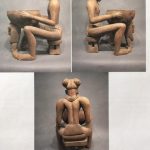
Western Grassland, Cameroon
31” h, 18” w, 23” d
 Other views
Other viewsThis northern kingdom is known to be a “society of princes” who are related to the ruling ”fon”. Many rulers had their masks or thrones made in Babanki-Tingo, an important center of sculpture.
The facial feature of this figure bears affinities with the classical Babanki style of the Cameroon Grassland, characterized by a rather narrow face and wide-spaced eyebrows outlined by an engraved contour. The inner corners of the almond-shaped eyes lie close together and at the height of the bridge of the nose. The notches around the nostrils meet at the point of the nose.
The figure wears an impressive beaded necklace and a bracelet on each wrist. The formal design of his coiffure recalls the cap worn by kings and various dignitaries of this region. This coiffure represent power and prosperity. That the figure is seated on a stool means he is of royal lineage. A seat is the most important symbol of kingship. Seating is a metaphor for the many levels and layers of hierarchy and stratification that characterize prerogative. The appearance of an animal figure, in this instance that of a lion, the king of the jungle, as a caryatid support for a ceremonial bowl in his hands, further underscore his power. The design of this figure proclaims loudly his royal lineage and power. It probably represents one of the princes who is responsible for naming a ruler’s successor. It is quite clear this figurine is an important piece. Its rarity is worth a place in a museum.